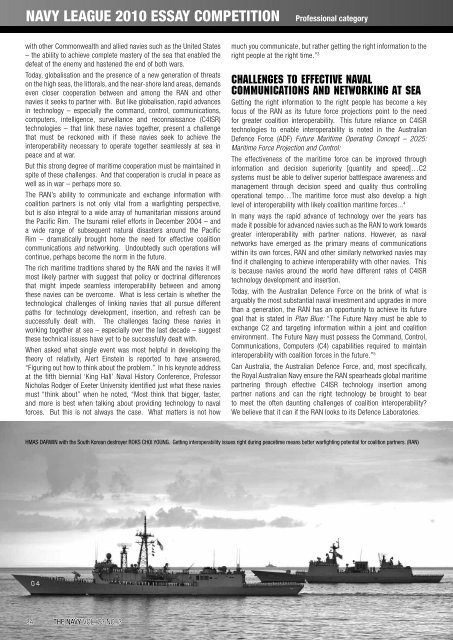The Navy Vol_73_No_3 Jul 2011 - Navy League of Australia
The Navy Vol_73_No_3 Jul 2011 - Navy League of Australia
The Navy Vol_73_No_3 Jul 2011 - Navy League of Australia
Create successful ePaper yourself
Turn your PDF publications into a flip-book with our unique Google optimized e-Paper software.
NAVY LEAGUE 2010 ESSAY COMPETITION<br />
Pr<strong>of</strong>essional category<br />
with other Commonwealth and allied navies such as the United States<br />
– the ability to achieve complete mastery <strong>of</strong> the sea that enabled the<br />
defeat <strong>of</strong> the enemy and hastened the end <strong>of</strong> both wars.<br />
Today, globalisation and the presence <strong>of</strong> a new generation <strong>of</strong> threats<br />
on the high seas, the littorals, and the near-shore land areas, demands<br />
even closer cooperation between and among the RAN and other<br />
navies it seeks to partner with. But like globalisation, rapid advances<br />
in technology – especially the command, control, communications,<br />
computers, intelligence, surveillance and reconnaissance (C4ISR)<br />
technologies – that link these navies together, present a challenge<br />
that must be reckoned with if these navies seek to achieve the<br />
interoperability necessary to operate together seamlessly at sea in<br />
peace and at war.<br />
But this strong degree <strong>of</strong> maritime cooperation must be maintained in<br />
spite <strong>of</strong> these challenges. And that cooperation is crucial in peace as<br />
well as in war – perhaps more so.<br />
<strong>The</strong> RAN’s ability to communicate and exchange information with<br />
coalition partners is not only vital from a warfighting perspective,<br />
but is also integral to a wide array <strong>of</strong> humanitarian missions around<br />
the Pacific Rim. <strong>The</strong> tsunami relief efforts in December 2004 – and<br />
a wide range <strong>of</strong> subsequent natural disasters around the Pacific<br />
Rim – dramatically brought home the need for effective coalition<br />
communications and networking. Undoubtedly such operations will<br />
continue, perhaps become the norm in the future.<br />
<strong>The</strong> rich maritime traditions shared by the RAN and the navies it will<br />
most likely partner with suggest that policy or doctrinal differences<br />
that might impede seamless interoperability between and among<br />
these navies can be overcome. What is less certain is whether the<br />
technological challenges <strong>of</strong> linking navies that all pursue different<br />
paths for technology development, insertion, and refresh can be<br />
successfully dealt with. <strong>The</strong> challenges facing these navies in<br />
working together at sea – especially over the last decade – suggest<br />
these technical issues have yet to be successfully dealt with.<br />
When asked what single event was most helpful in developing the<br />
theory <strong>of</strong> relativity, Alert Einstein is reported to have answered,<br />
“Figuring out how to think about the problem.” In his keynote address<br />
at the fifth biennial ‘King Hall’ Naval History Conference, Pr<strong>of</strong>essor<br />
Nicholas Rodger <strong>of</strong> Exeter University identified just what these navies<br />
must “think about” when he noted, “Most think that bigger, faster,<br />
and more is best when talking about providing technology to naval<br />
forces. But this is not always the case. What matters is not how<br />
much you communicate, but rather getting the right information to the<br />
right people at the right time.” 3<br />
CHALLENGES TO EFFECTIVE NAVAL<br />
COMMUNICATIONS AND NETWORKING AT SEA<br />
Getting the right information to the right people has become a key<br />
focus <strong>of</strong> the RAN as its future force projections point to the need<br />
for greater coalition interoperability. This future reliance on C4ISR<br />
technologies to enable interoperability is noted in the <strong>Australia</strong>n<br />
Defence Force (ADF) Future Maritime Operating Concept – 2025:<br />
Maritime Force Projection and Control:<br />
<strong>The</strong> effectiveness <strong>of</strong> the maritime force can be improved through<br />
information and decision superiority [quantity and speed]…C2<br />
systems must be able to deliver superior battlespace awareness and<br />
management through decision speed and quality thus controlling<br />
operational tempo…<strong>The</strong> maritime force must also develop a high<br />
level <strong>of</strong> interoperability with likely coalition maritime forces... 4<br />
In many ways the rapid advance <strong>of</strong> technology over the years has<br />
made it possible for advanced navies such as the RAN to work towards<br />
greater interoperability with partner nations. However, as naval<br />
networks have emerged as the primary means <strong>of</strong> communications<br />
within its own forces, RAN and other similarly networked navies may<br />
find it challenging to achieve interoperability with other navies. This<br />
is because navies around the world have different rates <strong>of</strong> C4ISR<br />
technology development and insertion.<br />
Today, with the <strong>Australia</strong>n Defence Force on the brink <strong>of</strong> what is<br />
arguably the most substantial naval investment and upgrades in more<br />
than a generation, the RAN has an opportunity to achieve its future<br />
goal that is stated in Plan Blue: “<strong>The</strong> Future <strong>Navy</strong> must be able to<br />
exchange C2 and targeting information within a joint and coalition<br />
environment. <strong>The</strong> Future <strong>Navy</strong> must possess the Command, Control,<br />
Communications, Computers (C4) capabilities required to maintain<br />
interoperability with coalition forces in the future.” 5<br />
Can <strong>Australia</strong>, the <strong>Australia</strong>n Defence Force, and, most specifically,<br />
the Royal <strong>Australia</strong>n <strong>Navy</strong> ensure the RAN spearheads global maritime<br />
partnering through effective C4ISR technology insertion among<br />
partner nations and can the right technology be brought to bear<br />
to meet the <strong>of</strong>ten daunting challenges <strong>of</strong> coalition interoperability?<br />
We believe that it can if the RAN looks to its Defence Laboratories.<br />
HMAS DARWIN with the South Korean destroyer ROKS CHOI YOUNG. Getting interoperability issues right during peacetime means better warfighting potential for coalition partners. (RAN)<br />
24 THE NAVY VOL. <strong>73</strong> NO. 3

















